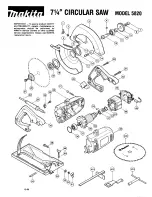
6
the material is cut and weakens, it will sag,
causing a pinched blade.
• Support large panels as shown (
Fig. 1
).
Material supported only at the ends (
Fig. 2
)
will lead to blade pinching.
• Avoid sawing overhead. Material can sag
and will pinch blade.
• Insure that the material to be cut is clamped
(
figure 3
) and solidly supported and
balanced on a strong, stable and level work
surface. Support the work so that the wide
portion of the saw shoe is on the portion of
the material that doesn’t fall after the cut is
made. Never hold cut off piece by hand
(
figure 4
)
• Keep blades sharp and clean.
• Use fence or straight edge guide when
ripping. Be careful as the cut off strip can
sag or twist, closing the cut and pinching the
blade, leading to KICKBACK.
• Don’t force tool. Wood variables such as
knots, hardness, toughness, wetness,
pressure treated and freshly cut green
lumber can heavily load the saw which can
lead to stalling. Push the saw slower when
this occurs.
• Don’t remove saw from work during a cut
while the blade is moving.
• Allow saw to reach full speed before blade
contacts material to be cut. Starting the saw
with the blade against the work or pushed
forward into cut can lead to stalling or
sudden backward movement of saw.
• Never attempt to lift saw when making a bevel
cut. This leads to blade binding and stalling.
• Always secure work to prevent workpiece
movement during cut.
• Do not try to force saw back on line if your
cut begins to go off line. This can cause
KICKBACK. Stop saw and allow blade to
coast down to a stop. Withdraw from cut and
start a new cut on the line.
• Set depth adjustment of saw such that
one tooth of the blade projects below the
workpiece as shown in
(figure 7).
• Do not back up a rotating blade in the cut.
Twisting the saw can cause the back edge
of the blade to dig into the material, climb
out of the work and run back toward the
operator.
• Avoid cutting nails. Inspect for and remove
all nails from lumber before cutting.
MOTOR
Be sure your power supply agrees with
nameplate marking. 120 Volts AC means
your tool will operate on standard 60 Hz
household power. Do not operate AC tools
on DC. A rating of 120 volts AC/DC means
that your tool will operate on standard 60 Hz
AC or DC power. This information is printed
on the nameplate. Lower voltage will cause
loss of power and can result in over-heating.
All PORTER-CABLE
tools are factory-tested;
if this tool does not operate, check the power
supply. This tool is AC only.
INTENDED USE
This circular saw is designed for wood cutting
applications.
Do not
use water feed attachments
with this saw.
Do not
use abrasive wheels or
blades.
Do not
use under wet conditions or in
presence of flammable liquids or gases.
SAVE THESE INSTRUCTIONS
3
4
1
2







































